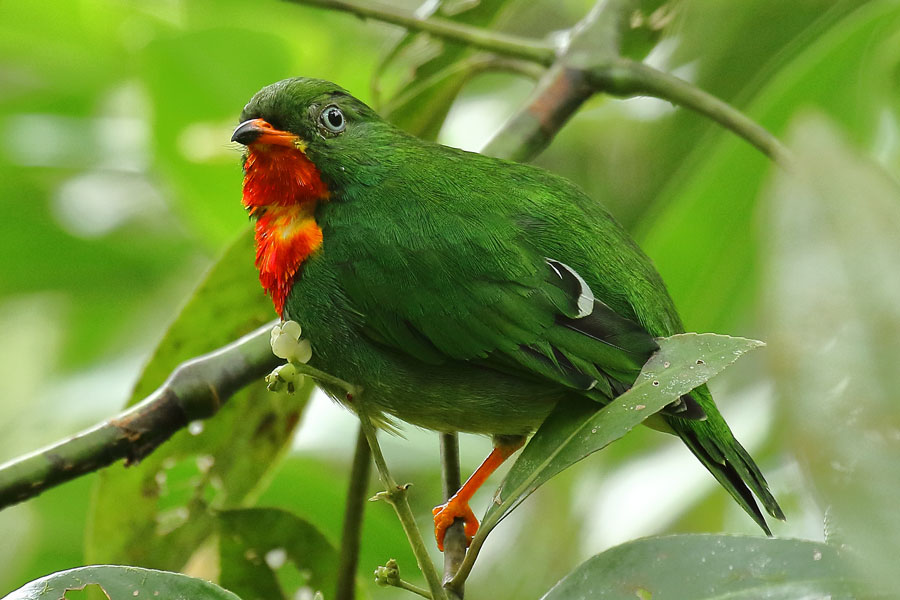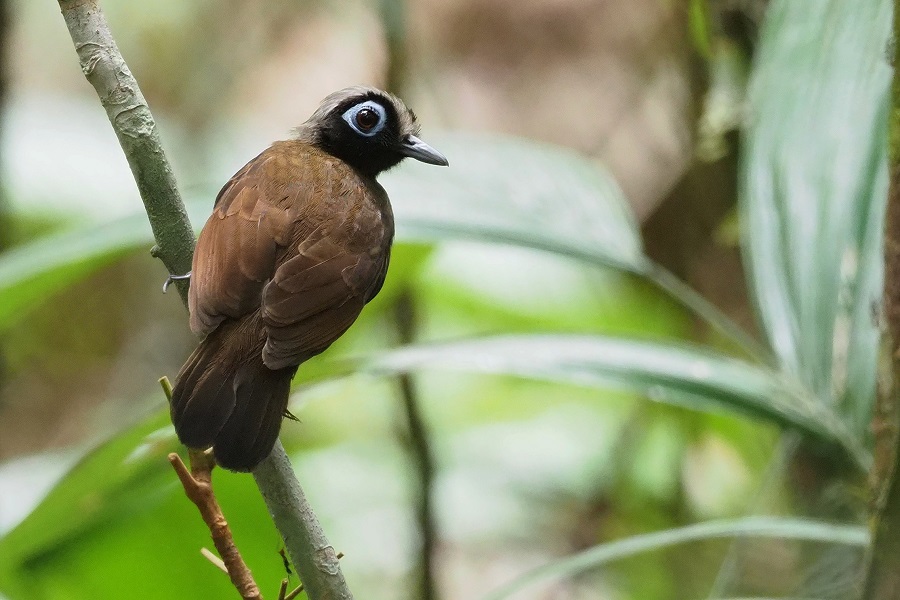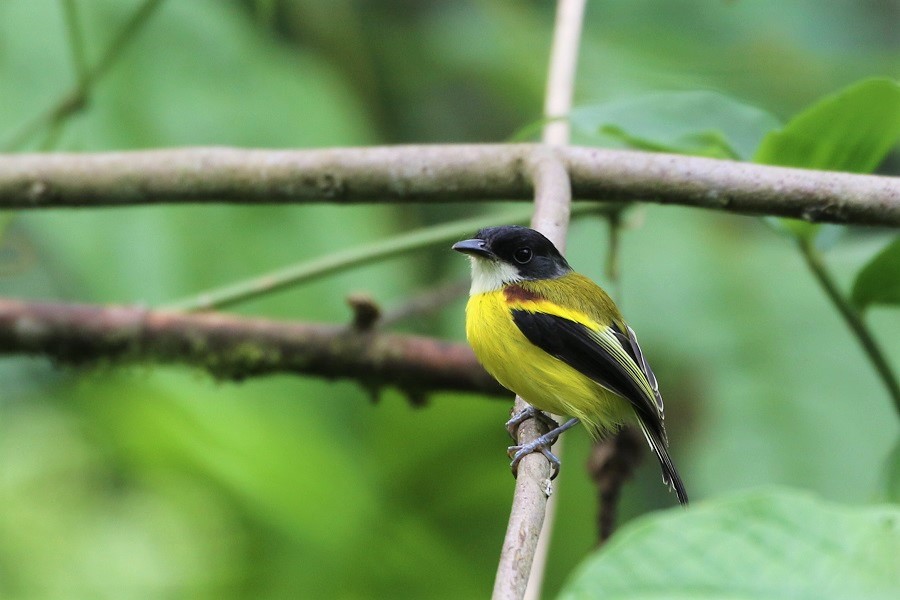Colombia: South Cross-Andean Expedition
Embark on a truly unique adventure that combines the captivating high Magdalena Colombian endemics and potential splits with some particularly scarce endemic treasures of both the east and west Andean slopes, all while birding in extensive tracts of pristine forest. Includes visits to the best sites for Black Tinamou, Hoary Puffleg, Butterfly Coquette, Spot-fronted Swift, Orange-fronted Barbet, Hooded Antpitta, Schwartz’s Antthrush, White-rimmed and Dusky-headed Brushfinches, White-faced Nunbird, Chestnut-bellied Cotinga, Scarlet-and-white Tanager, Blue-browed Tanager, and Masked Mountain Tanager. This previously troubled region is now on the map for international birders!
Next Dates
Accommodation:
Some moderately basic nights in guesthouses without hot water, but otherwise comfortable accommodation.
Walking difficulty:
Moderate to strenuous, with some particularly long day hikes involving several hundred metres of elevation gain over 5-10 km, taken at birding pace.
Tour cost includes:
All accommodation, main meals, drinking water, internal flights (as stated in itinerary), overland transport, tips to local drivers and guides, travel permits, entrance fees, and guide fees.
Tour cost excludes:
Flights before and after the tour start/end, visa, travel insurance, tips to tour leaders, laundry, drinks, and other items of a personal nature.
Day 1: The tour starts at Bogotá International Airport (BOG) this evening. Night near the airport.
Day 2: After a short morning flight to Pitalito, we will look for the isolated high-Magdalena Valley population of Large-headed Flatbill and then arrive at the charming El Encanto Reserve for a two-night stay. This afternoon, we should hopefully have time to connect with Short-tailed Emerald and the endemic Indigo-capped Hummingbird. Night at El Encanto Reserve.
Day 3: We will concentrate on birding at La Drymophila Reserve above El Encanto, where feeders attract Hooded Antpitta and Schwartz’s Antthrush, while a few endemics like Dusky-headed Brushfinch, East Andean Antbird, and Tolima Blossomcrown thrive nearby. We will also be on the move chasing Spot-winged Parrotlets if they have been seen in the area, and checking the El Encanto feeders for the inexpectatus subspecies of Black-striped Sparrow (another high-Magdalena Valley potential split). Night at El Encanto Reserve.
Day 4: After a morning visit to La Drymophila cleaning up any missing targets, we will drive to Mocoa, making stops along the way for the “Magdalena” Maroon-tailed Parakeet and Magdalena Tapaculo. Night at Mocoa.
Day 5: We will spend the whole morning and part of the afternoon hiking the Sachamates Trail, which is undoubtedly the best place in the world for the elusive Black Tinamou. Other specialties from the area include the range-restricted Blue-rumped Manakin, Coppery-chested Jacamar, Black-streaked and Western Striolated Puffbirds, and White-streaked Antvireo. At the end of the day, we will drive to Puerto Asis for overnight.
Day 6: Most of the morning, we will be birding Hojarasca Center near Puerto Asis. In January, this small reserve is the best stake out for Butterfly Coquette visiting feeders and flowers. Some hard-to-see crakes are possible in the nearby marshy areas: Black-banded Crake, Rufous-sided Crake and Grey-breasted Crake. We can also expect to see Cinereous Tinamou, which is quite cooperative here, along with some other specialties like Riparian Parrotlet, Riparian Antbird, Rufous-headed Woodpecker, and White-lored Antpitta. After a midday drive, this afternoon we will start our hike to access an amazing piece of pristine forest known as La Isla Escondida.
Day 7-8: This “island” between the rivers Guamúez and Río Claro offers some of the best mid-elevation East Andean slope birding in Colombia, and targets will include both Nocturnal and Salvin’s Curassows, a plethora of good antbirds like Fulvous Antshrike, Foothill and Ornate Stipplethroats, White-plumed and Hairy-crested Antbirds chasing army ants, and Black Antbird. There are several scarce species that have recently been added to Colombia's list here, so Foothill Schiffornis, Western Striolated Puffbird, Buff-throated Tody-Tyrant, and Foothill Elaenia will also be on the menu, as well as other sought-after and more colourful species like Gould’s Jewelfront, Pavonine Quetzal, Golden-collared Toucanet, White-throated Woodpecker, Black-and-white and Golden-winged Tody-Flycatchers, Fiery-throated Fruiteater, and Grey-tailed Piha, among many others. Owling is quite productive at this reserve, with Band-bellied and Crested Owls, Napo Screech Owl, and others showing regularly. Additional species might include Ecuadorian Piedtail, Ecuadorian Tyrannulet, Fulvous Shrike Tanager, and Orange-eared Tanager. Nights at La Isla Escondida.
Day 9: After a last morning cleaning up targets from La Isla Escondida, we will head back to Mocoa for a good rest before a long climb up into the Andes the next day.
Day 10: Today, we will be birding from the lowlands to the high Andes on a fully-forested slope road known as El Trampolín. We will be targeting goodies such as Deep-blue Flowerpiercer, White-rimmed Brushfinch, Subtropical Pygmy Owl, Golden-eared, Blue-browed, and Orange-eared Tanagers, Chestnut-breasted Coronet, Grey-mantled Wren, Spectacled Prickletail, White-streaked Antvireo, and even the endemic Red-bellied Grackle, which makes an occasional appearance. Night in Sibundoy.
Day 11: We will dedicate our morning to the Bordoncillo Páramo searching for a scarce high-elevation specialty: Chestnut-bellied Cotinga. We also will have good chances of adding other rare species like Masked Mountain Tanager, along with Rainbow-bearded Thornbill, Agile Tit-tyrant, and more. We will then make a short stop at La Cocha lake for lunch and some balcony birding, before a longish drive to La Planada Reserve. Night at La Planada.
Day 12: Birding in La Planada Reserve is quite entertaining, as a lot of Chocó and West Andean slope specialties are available! Highlights include Plate-billed Mountain Toucan, Club-winged Manakin, Rufous-gaped Hillstar, Empress Brilliant, Cloud-forest Pygmy Owl, Toucan Barbet, Bicoloured Antvireo, Zeledon’s Antbird, Nariño and Chocó Tapaculos, Beautiful Jay, Chocó Warbler, Glistening-green Tanager, and Indigo Flowerpiercer, among many others. This is one of the oldest protected reserves in Colombia, and some other interesting targets like White-faced Nunbird, Spot-fronted Swift, and Hoary Puffleg are more common here than on the other birding circuits of Colombia and Ecuador. Night at Bangsias Lodge.
Day 13: A little lower than La Planada, the Bangsias Reserve area offers a completely different set of Chocó endemics, including goodies like Moss-backed, Scarlet-and-white, Ochre-breasted, and Purplish-mantled Tanagers, Scaled and Orange-breasted Fruiteaters, Pacific Parakeet, Brown Inca, Purple-bibbed Whitetip, Toucan Barbet, Esmeraldas Antbird, and Black-chinned Mountain-Tanager. We will be birding a couple of trails and roadside where some trickier species like Rufous-brown Solitaire, Chocó Vireo, and Yellow-green Tanager could surprise us. At the end of the afternoon, we will drive towards the Pacific to spend the night by the beach. Night at Hotel Los Corales.
Day 14: On our last day of the trip, we will head not too far from town to look for some range-restricted specialties like Ochraceous Attila, Guayaquil Woodpecker, Orange-fronted Barbet, and Pacific Parrotlet. Birding the semi-open areas and fields from rural roads should also deliver some other more common species that barely make it into Colombia, like Ecuadorian and Croaking Ground Doves, Pallid Dove, and Chestnut-throated Seedeater. We will fly to Bogotá by mid-afternoon today, where this exciting tour ends in the evening.




























